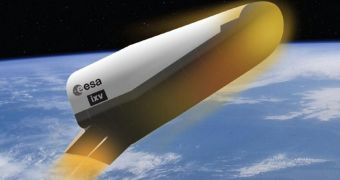Officials with the European Space Agency (ESA) have recently announced that their Intermediate Experimental Vehicle (IXV) spacecraft is currently getting closer to finishing the integration stage in its construction process, which is taking place in Turin, Italy. By May, the new vehicle will be sent to South America for additional assessments, ahead of a test flight later in the year.
After IXV integration concludes, the spacecraft will be sent to the ESA Kourou Spaceport, in French Guiana, South America, for acoustic and vibrations testing, the agency said. Once this is done, the vehicle will be integrated with its Vega light-lift delivery system. The launcher will lift IXV to an altitude of around 320 kilometers (200 miles) during its maiden flight.
Once separated from the rocket, the spacecraft will reach an apogee of around 412 kilometers (256 miles) above Earth's surface, before pointing its nose down at a 5-degree angle, and heading for atmospheric reentry. IXV is designed to splash down in the southern Pacific Ocean. Its fall will be cushioned by a series of advanced parachutes.
The reentry technology demonstration spacecraft weighs in at around 1,800 kilograms (4,000 pounds), and is unmanned. It is one of the most important parts of the ESA Future Launchers Preparatory Program, which aims to advance technologies that will be used on the Next Generation Launcher, a replacement for the Ariane 5 rocket. The IXV project costs around €200 million ($274 million).
ESA last dabbled with this type of spacecraft on October 21, 1998, when an Ariane V rocket carried the Advanced Reentry Demonstrator (ARD) vehicle on a suborbital reentry test. The mission was successful, with the craft splashing down within 4.9 kilometers (3 miles) of its mark, Space News reports.
IXV-class spacecraft could be used for a variety of applications, Program Manager Giorgio Tumino argues, including for conducting sample-return missions to Mars, and for returning experiments and other items from the International Space Station. The Automated Transfer Vehicles that ESA uses for delivering supplies to the space lab are always destroyed upon atmospheric reentry.
The new demonstrator is outfitted with 300+ sensors, which will allow engineers to monitor every aspect of its flight through the atmosphere. Extra thrusters and flaps will allow it to maintain a proper orientation throughout its flight. IXV is being built by Thales Alenia Space as a lifting-body vehicle shaped like a shoe, and is just 5 meters long, 2.2 meters wide, and 1.5 meters high (16.4x7.2x4.9 feet).
“The manifest is certainly complex this year. For IXV and the Vega program our first priority is to arrive in Kourou to be ready for an October [launch] slot,” says the head of the Launcher Development Department at ESA, Stefano Bianchi.

 14 DAY TRIAL //
14 DAY TRIAL //